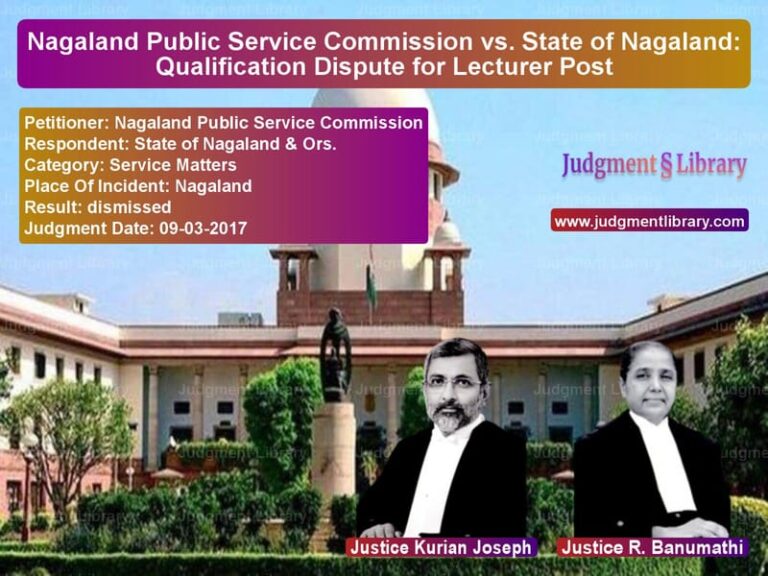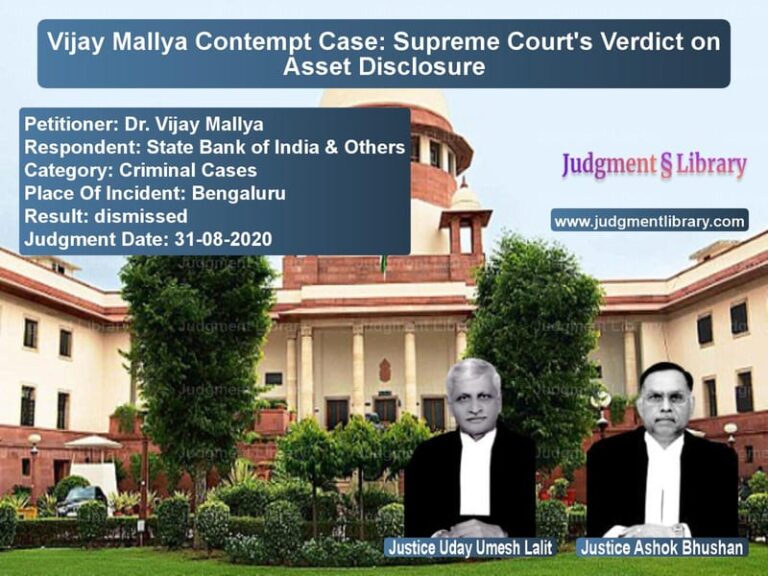ONGC Workers’ Regularization: Supreme Court’s Landmark Decision on Employment Rights
The case of Oil and Natural Gas Corporation (ONGC) v. Krishan Gopal & Ors. revolves around the employment rights of temporary and contract workers seeking regularization in ONGC. The Supreme Court examined the legality of regularization claims, the scope of industrial adjudication, and the applicability of the Constitution Bench ruling in Secretary, State of Karnataka v. Umadevi. This ruling clarifies the legal framework for regularizing temporary workers in government-owned enterprises and sets an important precedent for labor law in India.
Background of the Case
The dispute emerged when multiple High Courts across India directed ONGC to regularize workers who had been employed for years on a temporary or contract basis. The workers, through various petitions, claimed that ONGC had engaged in an unfair labor practice by continuing to employ them in temporary roles without granting them permanent employment status. The key High Court decisions came from Andhra Pradesh, Delhi, Madras, and Uttarakhand, all of which relied on the Supreme Court’s judgment in Petroleum Coal Labour Union (PCLU) to justify the demand for regularization.
ONGC challenged these High Court rulings, arguing that the directives to regularize workers were contrary to the principles laid down in the Constitution Bench ruling in Umadevi, which held that no irregularly appointed worker could claim a right to be made permanent unless employed through a proper selection process.
Legal Issues Involved
- Whether ONGC workers were entitled to regularization solely based on prolonged temporary employment.
- Whether the ruling in PCLU was in line with the binding precedent set by Umadevi.
- Whether Industrial Tribunals and High Courts had the power to direct regularization of workers despite the absence of sanctioned posts.
- Whether contract and temporary employees could bypass the Industrial Disputes Act and directly seek relief under Article 226 of the Constitution.
Petitioners’ Arguments
ONGC, represented by senior legal counsel, contended:
- The PCLU ruling, which was the basis for the High Court decisions, was per incuriam (given in ignorance of binding precedent) as it failed to consider previous Supreme Court judgments on unfair labor practices.
- The High Courts erred in directing regularization without requiring the workers to prove that they had been recruited through a proper process.
- The Industrial Disputes Act, 1947, provides a statutory mechanism for resolving labor disputes, and workers should have approached Industrial Tribunals instead of filing writ petitions in High Courts.
- The Constitution Bench ruling in Umadevi clearly states that temporary employment cannot create a vested right to regularization.
- There were no sanctioned posts available for regularization, and High Court directives were forcing ONGC to create posts beyond its financial and administrative capacity.
Respondents’ Arguments
The workers, supported by various trade unions, countered ONGC’s claims, arguing:
- They had been working for years, performing duties equivalent to those of regular employees but were deliberately denied permanent status.
- The continuation of workers as temporary employees for years constituted an unfair labor practice under the Industrial Disputes Act.
- ONGC had created a de facto system of permanent temporary employment to circumvent its obligations under labor laws.
- Many similarly placed workers had already been regularized by ONGC, leading to discrimination against those who had not been granted the same status.
- Employment policies in public sector enterprises must be subject to judicial scrutiny to prevent exploitation of labor.
Supreme Court’s Analysis
The Supreme Court analyzed whether ONGC was bound to regularize these workers based on judicial orders and examined the interpretation of labor laws, standing orders, and constitutional provisions. Key observations included:
- The ruling in PCLU was not consistent with the principles laid down in Umadevi, as it failed to differentiate between irregular appointments and temporary employment due to administrative exigencies.
- Industrial Tribunals and High Courts cannot direct the regularization of workers without verifying whether the employment was made through a legal and competitive process.
- The High Courts wrongly assumed that prolonged temporary employment automatically grants a right to regularization.
- The financial and administrative implications of mass regularization orders were not considered by the High Courts, which could lead to an unsustainable burden on ONGC.
- The proper remedy for temporary workers was to seek relief under the Industrial Disputes Act through appropriate forums rather than filing writ petitions.
Final Judgment
The Supreme Court ruled in favor of ONGC, setting aside the High Court orders that had directed regularization. The key rulings included:
- The appeals filed by ONGC were allowed, and the High Court judgments directing regularization were quashed.
- The ruling in PCLU was overruled to the extent that it contradicted Umadevi.
- Temporary workers do not acquire an automatic right to regularization solely based on prolonged employment.
- Workers seeking regularization must approach Industrial Tribunals under the framework of the Industrial Disputes Act.
- ONGC was directed to frame a policy for dealing with temporary employees to ensure fair treatment while maintaining financial sustainability.
Impact of the Judgment
This ruling has significant implications for labor laws, public sector enterprises, and judicial intervention in employment matters:
- It reaffirms the Supreme Court’s stance that irregular employment does not grant an inherent right to regularization.
- It ensures that public sector undertakings like ONGC are not forced to absorb temporary workers in the absence of sanctioned posts.
- It clarifies the limited scope of judicial intervention in employment disputes, reinforcing the role of Industrial Tribunals in labor matters.
- It protects financial institutions from being overburdened with forced employment liabilities.
- It directs government-owned corporations to implement transparent employment policies to avoid exploitation and unfair labor practices.
By upholding ONGC’s appeal, the Supreme Court has provided clarity on the legal framework governing the regularization of temporary employees, ensuring that employment policies remain within constitutional and statutory boundaries.
Petitioner Name: Oil and Natural Gas Corporation (ONGC).Respondent Name: Krishan Gopal & Ors..Judgment By: Justice Dhananjaya Y. Chandrachud, Justice Ajay Rastogi.Place Of Incident: India.Judgment Date: 07-02-2020.
Don’t miss out on the full details! Download the complete judgment in PDF format below and gain valuable insights instantly!
Download Judgment: Oil and Natural Gas vs Krishan Gopal & Ors. Supreme Court of India Judgment Dated 07-02-2020.pdf
Direct Downlaod Judgment: Direct downlaod this Judgment
See all petitions in Employment Disputes
See all petitions in Public Sector Employees
See all petitions in Judgment by Dhananjaya Y Chandrachud
See all petitions in Judgment by Ajay Rastogi
See all petitions in allowed
See all petitions in Quashed
See all petitions in supreme court of India judgments February 2020
See all petitions in 2020 judgments
See all posts in Service Matters Category
See all allowed petitions in Service Matters Category
See all Dismissed petitions in Service Matters Category
See all partially allowed petitions in Service Matters Category







